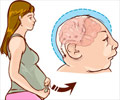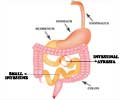- Annular pancreas - (https://medlineplus.gov/ency/article/001142.htm)
- Pancreas, annular - (https://rarediseases.info.nih.gov/diseases/705/annular-pancreas)
- Kobayashi S, Hoshino H, Segami K, Koizumi S, Ooike N, Otsubo T. Incomplete annular pancreas with ectopic opening of the pancreatic and bile ducts into the pyloric ring: First report of a rare anomaly., Case Reports in Gastroenterology (2016 - (https://doi.org/10.1159/000447292)
What is Annular Pancreas?
Annular pancreas is a rare condition that develops at birth. Although some newborns suffer at the onset, the symptoms go unnoticed in most cases and may manifest in adulthood. Annular pancreas occurs when the pancreas blocks the duodenum (part of the small intestine that involves digestion), completely or partially, by encircling it. The duodenum is obstructed (stenosis) and partially digested food may be unable to pass through the small intestine.
Annular pancreas occurs in newborns at a rate of 1 in 50,000 births. Obstruction of the duodenum is commonly observed in infants. In adults, besides obstruction of the duodenum, the other associated conditions that trigger the symptoms, include peptic ulcers, pancreatitis, and rarely, obstructive jaundice.
Males are more inclined to be affected with annular pancreas than females.
What Causes Annular Pancreas?
Annular pancreas is a congenital condition, which means the condition occurs at birth. Annular pancreas is due to flaws in pancreatic growth in the 4th month of embryological development. The malformation of the pancreas causes one part of the developing pancreas to rotate incompletely with the duodenum. The pancreas forms a ring structure around the duodenum. If a partial incomplete ring is formed, then there is no constriction of the duodenum. This occurs in 75% of the cases. If the ring is complete, then the duodenum is constricted. This is seen in 25% of the cases.
What are the Signs and Symptoms of Annular Pancreas?
The signs and symptoms vary based on the age of the individual.
Newborns are unable to feed well and spit up food more often than usual.
Adults experience the following symptoms:
- Pain in the abdomen due to cramps
- Nausea
- Vomiting blood
- Stuffed feeling after eating
- Obstructed biliary gland
- Obstructed duodenum
- Loss in weight
- Peptic ulcers
- Pancreatitis
Even if the pancreas completely encircles the duodenum, peptic ulcers and pancreatitis may prevent food from passing through the duodenum.

How Do You Diagnose Annular Pancreas?
Your physician will examine the clinical symptoms and recommend imaging to confirm the diagnosis. The upper gastrointestinal series (upper GI) is the preferred site of imaging.
To ensure correct diagnosis, imaging techniques are useful to diagnose annular pancreas. Ultrasound imaging of the fetus can detect a dilated duodenum and complications in the development of the pancreas. Abdominal radiographs show a double bubble sign to indicate obstruction in the duodenum. However, in some cases, a barium meal study and surgical exploration of the affected area help to confirm diagnosis.
Postnatal diagnosis is based on clinical symptoms and imaging results.
- Magnetic resonance cholangiopancreatography (MRCP) is non-invasive but cannot accurately detect annular pancreas if the pancreatic duct is not dilated.
- Computed tomography is another imaging technique used to diagnose annular pancreas.
- Endoscopic retrograde cholangiopancreatography (ERCP) - ERCP can accurately images the annular pancreatic duct that encircles the duodenum. However, the technique is invasive and may be unable to detect certain cases of obstructed duodenum. Besides ERCP could cause pancreatitis.

How Do You Treat Annular Pancreas?
Treatment strategy should be personalized and cater to the individual’s requirements based on the diagnosis.
Surgery is the best way to treat annular pancreas.
In severe cases of duodenum obstruction in children and adults, duodenum bypass is performed.
Duodenojejunostomy and Duodenoduodenostomy are recommended methods of surgery in adults and children, respectively.
In a rare subtype of annular pancreas, pancreatoduodenectomy was performed and the patient did not experience any complications following the surgery. The patient had a unique case of the pancreatic duct and the bile duct, opening into the pyloric ring (the junction between the stomach and the duodenum). Pancreatoduodenectomy is performed only in cases complicated with pancreatitis.
Another rare case of annular pancreas was treated successfully with laparoscopic duodenojejunostomy.
Removing (resection) the pancreatic tissue is rarely performed because of the complications involved in the procedure, e.g. reduced permanent cure rate, pancreatitis, repeated obstruction of the duodenum, and reduced relief rate.
What are the Complications of Annular Pancreas?
Annular pancreas is diagnosed due to symptoms that develop with associated conditions, such as gastrointestinal problems at birth, Down syndrome, peptic ulcer, pancreatitis, and extra amniotic fluid during pregnancy.
How Can You Prevent Annular Pancreas?
Annular pancreas is a birth defect and hence cannot be prevented. It can be diagnosed before birth and appropriate management strategies may be adopted to deal with the condition.










